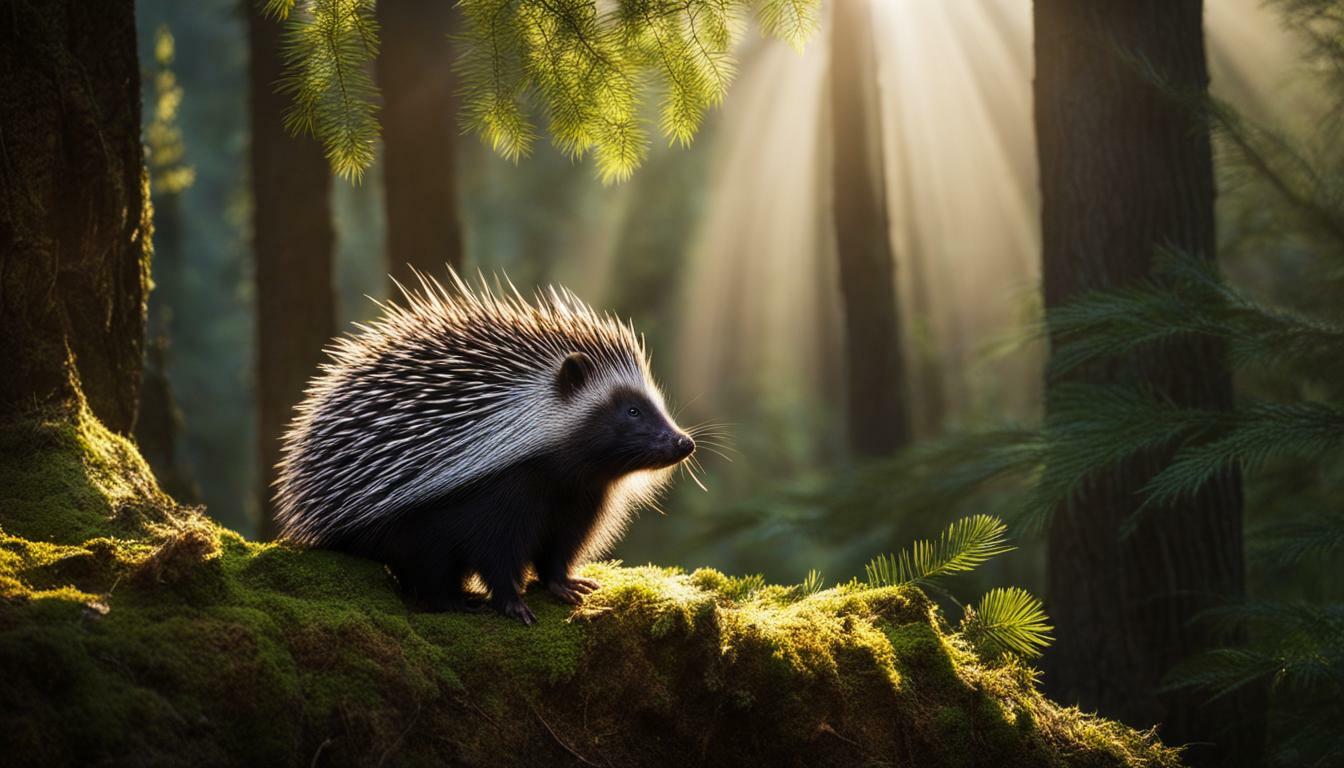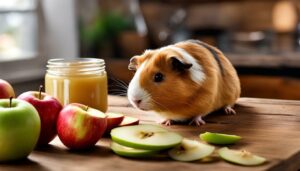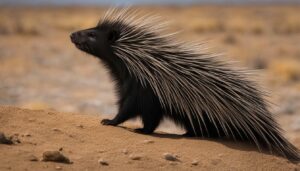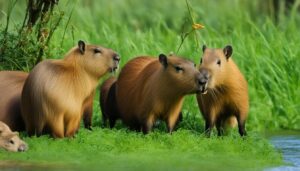Porcupines are fascinating creatures known for their unique tree-dwelling habits and behavior in tree habitats. These skilled climbers use their sharp claws to pull themselves upward and can often be found in the upper canopy of trees, especially during the early spring when they eat and rest. While they are closely related to guinea pigs and agouti, porcupines have a distinctive defense mechanism – quills. However, contrary to popular belief, they do not shoot their quills at predators. Instead, the quills stick into the predators and are pulled out when they retreat. When threatened, porcupines emit a strong odor and raise their quills as a warning.
Porcupines face predation from various animals such as owls, coyotes, wolves, and fishers. With over 30,000 quills on their body, they have a high number of quills for defense. These quills have special adaptations, including a coating of antibiotics, which aids in healing injuries sustained while in trees.
As herbivores, porcupines have a unique diet that includes wood and a craving for salt. These tree-dwelling creatures play a role in trimming trees and shaping the surrounding habitat. Additionally, they provide nesting sites for other animals.
Key Takeaways:
- Porcupines are skilled climbers and live in tree habitats, especially in the upper canopy.
- Their defense mechanism involves sticking quills into predators, rather than shooting them.
- When threatened, porcupines emit a strong odor and raise their quills.
- They face predation from animals like owls, coyotes, wolves, and fishers.
- Porcupines have over 30,000 quills, with special adaptations for healing.
- These herbivores eat wood and play a role in trimming trees and providing habitat.
Porcupine Tree Adaptations
Porcupines have remarkable adaptations that allow them to thrive in tree habitats, making them highly skilled climbers. Their unique adaptations enable them to navigate through branches and cling to trees with ease. One of the key adaptations is their strong, curved claws that provide them with a secure grip on tree trunks and branches. These specialized claws enable porcupines to pull themselves upward, making it possible for them to reach the upper canopy of trees where they often reside.
In addition to their claws, porcupines possess a dense coat of quills that serve as a form of protection. Contrary to popular belief, porcupines do not shoot their quills at predators. Instead, the quills have a barbed structure that allows them to stick into predators and cause discomfort when the predator retreats. This defense mechanism, combined with the ability to emit a strong odor and raise their quills when threatened, helps porcupines ward off potential predators.
Another fascinating adaptation of porcupines is their quills. These quills, numbering over 30,000 on their body, provide them with excellent defense against predators. What makes these quills even more remarkable is their antibacterial properties. The quills are coated with a substance that acts as a natural antibiotic, helping to prevent infections in case of injuries sustained while climbing trees. This adaptation ensures the porcupines’ well-being and aids in their ability to thrive in their tree habitats.
| Porcupine Tree Adaptations |
|---|
| Strong, curved claws for climbing |
| Barbed quills for defense |
| Quills coated with antibiotics for healing |
Climbing Ability of Porcupines
Porcupines possess impressive climbing abilities, using their sharp claws to effortlessly ascend trees and navigate through branches. These spiky mammals have adapted to life in the treetops, where they feel most at home. With their long claws and strong limbs, porcupines can skillfully maneuver their way up even the tallest of trees.
When climbing, porcupines rely on their powerful grip and agility. Their specialized claws provide a secure footing, allowing them to traverse branches with ease. With their quills hugged close to their bodies, they can slip through tight spaces in the branches, almost appearing as though they are floating between trees.
Climbing Techniques:
- Branch-to-Branch Leaping: Porcupines can leap from one branch to another, using their muscular hind legs to propel themselves forward. This technique allows them to cover larger distances and access different areas of the tree canopy.
- Vertical Ascent: Porcupines are adept at climbing vertically, even on relatively smooth tree trunks. Their strong claws grip onto the bark, providing them with stability and support as they make their way upwards.
- Branch Balancing: Porcupines are able to balance on thin tree branches with remarkable precision. Their long and bushy tails act as a counterbalance, aiding in their stability and preventing them from losing their footing.
- Trunk Hugging: When moving between trees or descending to the ground, porcupines often hug the trunk, using their claws and quills to anchor themselves securely. This technique helps them transition smoothly between different parts of their tree habitat.
Throughout their tree-climbing endeavors, porcupines rely on their keen sense of balance, agility, and strength. Their climbing abilities not only allow them to reach food sources and escape from predators but also play a crucial role in shaping the tree ecosystem by contributing to the trimming of branches and creating opportunities for other arboreal animals.
| Porcupine Climbing Abilities | Techniques Used |
|---|---|
| Vertical Ascent | Claw grip, muscular strength |
| Branch-to-Branch Leaping | Muscular hind legs, agility |
| Branch Balancing | Bushy tail, counterbalance |
| Trunk Hugging | Claw and quill anchoring |
Porcupine Tree Nesting
Porcupines exhibit interesting nesting behavior in trees, constructing cozy nests high above the ground to rest and raise their young. These nests, also known as dreys, are built using a combination of twigs, branches, and leaves. Porcupines are skilled climbers and use their claws to scale tall trees, where they select a suitable location for their nest.
These tree nests provide porcupines with protection from predators and severe weather conditions. The nests are often located in the upper canopy of trees, hidden within dense foliage. This strategic positioning ensures that the porcupines are safely concealed while they rest during the day and raise their young.
Porcupine nests are typically small and sturdy, providing a secure environment for the porcupettes, which is the term used to refer to baby porcupines. The dreys are lined with soft materials such as leaves, moss, and grass to create a comfortable space for the newborns. These nests serve as a sanctuary for the porcupines, allowing them to retreat and seek refuge when needed.
Porcupine Tree Nesting: An Overview
In summary, porcupines display fascinating nesting behavior in trees by constructing well-crafted nests high above the ground. These nests provide them with protection, comfort, and an ideal environment to raise their young. By utilizing their climbing abilities and natural instincts, porcupines create safe havens in the treetops, contributing to their survival and the balance of tree ecosystems.
| Porcupine Tree Nesting | Summary |
|---|---|
| Behavior | Porcupines construct nests in trees to rest and raise their young. |
| Location | Nests are situated in the upper canopy of trees, hidden in dense foliage. |
| Structure | Nests are built using twigs, branches, and leaves, providing a secure and cozy space. |
| Protection | The nests offer protection from predators and harsh weather conditions. |
| Comfort | Porcupettes are raised in nests lined with soft materials like moss and grass. |
Porcupine’s Role in Tree Trimming
Porcupines play an essential role in tree trimming, as their diet consists of wood, which aids in shaping the vegetation and maintaining the health of the surrounding habitat. These unique creatures are herbivores and have a craving for salt, which leads them to gnaw on tree bark, branches, and twigs. By doing so, they effectively prune trees, regulating their growth and preventing overgrowth.
With their strong and sharp teeth, porcupines can easily chew through the tough outer layer of trees, exposing the nutrient-rich inner layers. This process helps create openings for sunlight to reach lower levels of vegetation, stimulating the growth of new plants and providing a more diverse habitat for other animals.
Porcupine feeding habits also contribute to seed dispersal. As they consume the bark and branches, they inadvertently ingest seeds that are then spread through their droppings. This dispersal helps with the regeneration and expansion of the forest ecosystem.
While porcupines are often associated with damaging trees, their role in tree trimming is essential for maintaining a healthy and balanced environment. By controlling the growth of vegetation, creating openings for sunlight, and aiding in seed dispersal, porcupines have a significant impact on the overall health and diversity of tree habitats.
| Porcupine’s Role in Tree Trimming | Benefits |
|---|---|
| Pruning of trees | Regulates tree growth and prevents overgrowth |
| Opening up the canopy | Allows sunlight to reach lower levels, promoting new plant growth |
| Seed dispersal | Helps with the regeneration and expansion of the forest ecosystem |
Porcupine Defense Mechanisms
Porcupines have evolved effective defense mechanisms, such as raising their quills and emitting a pungent odor, to protect themselves from predators while in their tree habitats. When threatened, porcupines will raise their quills, which are sharp and barbed, making it difficult for predators to attack them. These quills can become embedded in the predator’s skin, causing pain and discomfort. The predator often retreats, and the quills are eventually dislodged. This defense mechanism acts as a deterrent and helps porcupines ward off potential threats.
In addition to their quills, porcupines also emit a strong odor when they feel threatened. This odor serves as a warning sign to predators, indicating that the porcupine is not an easy prey to tackle. The combination of raised quills and pungent odor significantly reduces the chances of an attack by making the predator think twice before approaching.
While porcupines have these effective defense mechanisms, they still face threats from various predators in their tree habitats. Owls are known to be one of the main predators, taking advantage of the porcupine’s limited mobility in trees. Other predators, such as coyotes, wolves, and fishers, also pose a risk to porcupines. These predators must carefully consider their approach when hunting porcupines and weigh the risks associated with a potential attack.
| Predator | Threat Level |
|---|---|
| Owls | High |
| Coyotes | Moderate |
| Wolves | Moderate |
| Fishers | Moderate |
Despite these challenges, porcupines have found a way to survive and thrive in their tree habitats. Their defense mechanisms, along with their ability to climb trees, help keep them safe from predators. Porcupines play a vital role in ecosystems by contributing to tree trimming through their feeding habits and providing habitat for other animals.
Porcupine Predators
Porcupines face various predators in their tree habitats, including owls, coyotes, wolves, and fishers, which target them for food. These predators have developed different strategies to try and overcome the porcupine’s defense mechanisms. While the porcupine’s quills serve as a strong deterrent, some predators have learned how to attack without getting stuck.
Owls, for example, have specialized feathers that allow them to fly silently, making it easier for them to surprise their prey. They will often swoop down onto a porcupine from above, targeting vulnerable spots like the head or belly. Despite the porcupine’s quills, owls have evolved feathers that are specially designed to minimize the risk of injury.
Coyotes and wolves, on the other hand, have developed their own unique tactics for hunting porcupines. They will first attempt to flip the porcupine over, exposing the unprotected belly. By doing this, they can avoid the quills on the porcupine’s back. If successful, they will then go in for the kill by attacking vulnerable areas.
Fishers, a type of weasel, are renowned for their ability to take down porcupines. They are incredibly agile and can climb trees with ease, giving them an advantage in hunting porcupines. Fishers will relentlessly pursue a porcupine, trying to wear it down and expose its vulnerable areas. They are known to attack from multiple angles, using their sharp teeth to get past the quills.
| Predator | Hunting Strategy |
|---|---|
| Owls | Swoop from above, target vulnerable areas |
| Coyotes and wolves | Flip porcupine over, attack unprotected areas |
| Fishers | Relentlessly pursue, attack from multiple angles |
Quill Adaptations and Healing
Porcupines possess specialized quill adaptations, including antibacterial properties, which aid in both defense and healing from injuries sustained in their tree habitats. These quills are barbed, making them difficult to remove once embedded in a predator’s skin. The quills also contain microscopic backward-facing barbs that facilitate their attachment to the predator. As the predator retreats, the quills pull away from the porcupine, causing pain and discomfort.
In addition to their defensive function, porcupine quills have remarkable healing properties. Studies have revealed that the outer layer of the quills is coated with antibacterial substances, which prevent infection when the quills pierce the predator’s skin. This antibacterial coating not only protects the porcupine from potential harm but also aids in the healing process by minimizing the risk of infection in the wounded areas.
Porcupines’ ability to heal from injuries sustained while navigating through trees is further supported by the fact that they have an exceptionally high number of quills. On average, a porcupine has over 30,000 quills covering its body. This abundance of quills ensures that porcupines have a constant supply of new, sharp quills to replace any that may have been damaged or lost in encounters with predators or while maneuvering through the trees.
| Quill Adaptations | Quill Healing |
|---|---|
| Barbed structure for defense | Antibacterial coating prevents infection |
| Backward-facing microscopic barbs to attach to predators | Minimizes the risk of infection |
| Over 30,000 quills covering their body | Constant supply of new, sharp quills |
Porcupine Reproduction and Offspring
Porcupines have a unique reproductive cycle, giving birth to their young, called porcupettes, in the safety of their tree nests. The female porcupine, known as a sow, typically gives birth to only one porcupette per year. The gestation period lasts around seven months, and the young porcupette is born fully developed with quills already present.
- Porcupines are precocial animals, meaning that the porcupette is able to move and feed on its own shortly after birth. It is born with soft quills that harden within a few hours, providing it with immediate protection against predators.
- Once the porcupette is born, it will stay with its mother in the tree nest for several months. The sow provides care and nourishment to her young until it is capable of venturing out on its own. During this time, the porcupette learns essential survival skills, including tree climbing and foraging for food.
- As the porcupette grows, it will gradually explore its surroundings and become more independent. After reaching maturity, which typically occurs around one year of age, the porcupette will leave its mother’s nest and establish its territory in the tree habitat.
The reproductive cycle of porcupines ensures the survival of their species while also contributing to the diversity and balance of tree ecosystems. By giving birth in tree nests, porcupines provide a safe and protected environment for their young to grow and develop the skills they need to survive in their arboreal habitat.
| Porcupine Reproduction and Offspring |
|---|
| Giving birth |
| Unique reproductive cycle |
| One porcupette per year |
| Precocial animal |
| Porcupette’s independence |
| Mother’s care and nourishment |
| Learning survival skills |
| Establishing territory |
| Contribution to tree ecosystems |
Conclusion
Porcupines are fascinating creatures that have adapted to live in trees, showcasing remarkable climbing abilities, unique defensive mechanisms, and a significant impact on tree ecosystems.
These expert climbers are skilled at using their sharp claws to pull themselves upward, often finding refuge in the upper canopy of trees, particularly during the early spring when they rest and consume their meals. Although commonly mistaken for shooting their quills, porcupines do not possess such capability. Instead, their quills have barbs that stick into predators and detach when they retreat, leaving a painful reminder of their defense.
When threatened, porcupines emit a potent odor and raise their quills as a warning sign to potential predators. Unfortunately, these tree-dwelling mammals face threats from various predators such as owls, coyotes, wolves, and fishers.
With over 30,000 quills covering their bodies, porcupines have developed incredible adaptations, including quills coated with antibiotics, aiding in the healing process of injuries sustained while navigating tree habitats. Herbivores by nature, porcupines feast on wood and possess an intriguing craving for salt, further contributing to their unique dietary habits.
Additionally, porcupines play an essential role in tree ecosystems as they unintentionally trim trees with their feeding habits. This inadvertently helps shape the surrounding habitat and provides opportunities for other animals to find shelter and resources within these altered tree environments.
FAQ
Do porcupines live in trees?
Yes, porcupines do live in trees. They are skilled climbers and use their claws to pull themselves upward. They are often found in the upper canopy of trees, especially during the early spring when they eat and rest.
Are porcupines closely related to guinea pigs and agouti?
Yes, porcupines in the Americas are closely related to guinea pigs and agouti.
Do porcupines shoot their quills at predators?
No, porcupines do not shoot their quills at predators. Instead, the quills stick into the predators and are pulled out when they retreat.
What do porcupines do when they are threatened?
When threatened, porcupines emit a strong odor and raise their quills as a defense mechanism.
What predators prey upon porcupines in trees?
Animals like owls, coyotes, wolves, and fishers are known to prey upon porcupines in their tree habitats.
How many quills do porcupines have?
Porcupines have a high number of quills, with over 30,000 on their body.
Do porcupines have any special adaptations?
Yes, porcupines have special adaptations such as quills coated with antibiotics, which help them heal from injuries sustained while in trees.
What do porcupines eat?
Porcupines are herbivores and eat wood. They also have a craving for salt.
How many offspring do porcupines have?
Porcupines give birth to one baby called a porcupette each year.
What role do porcupines play in tree ecosystems?
Porcupines play a role in trimming trees and providing habitat for other animals.




